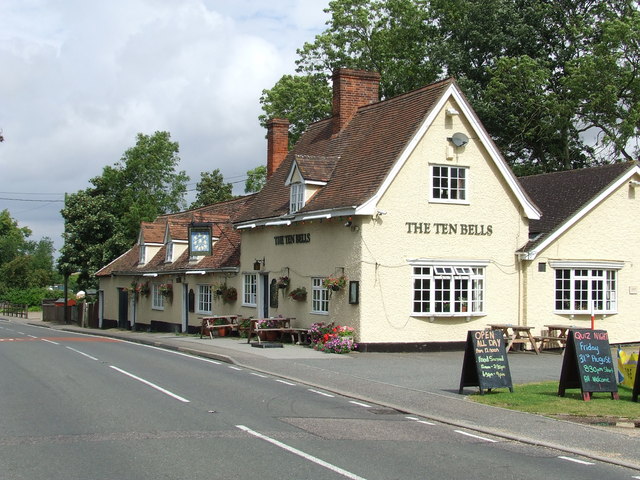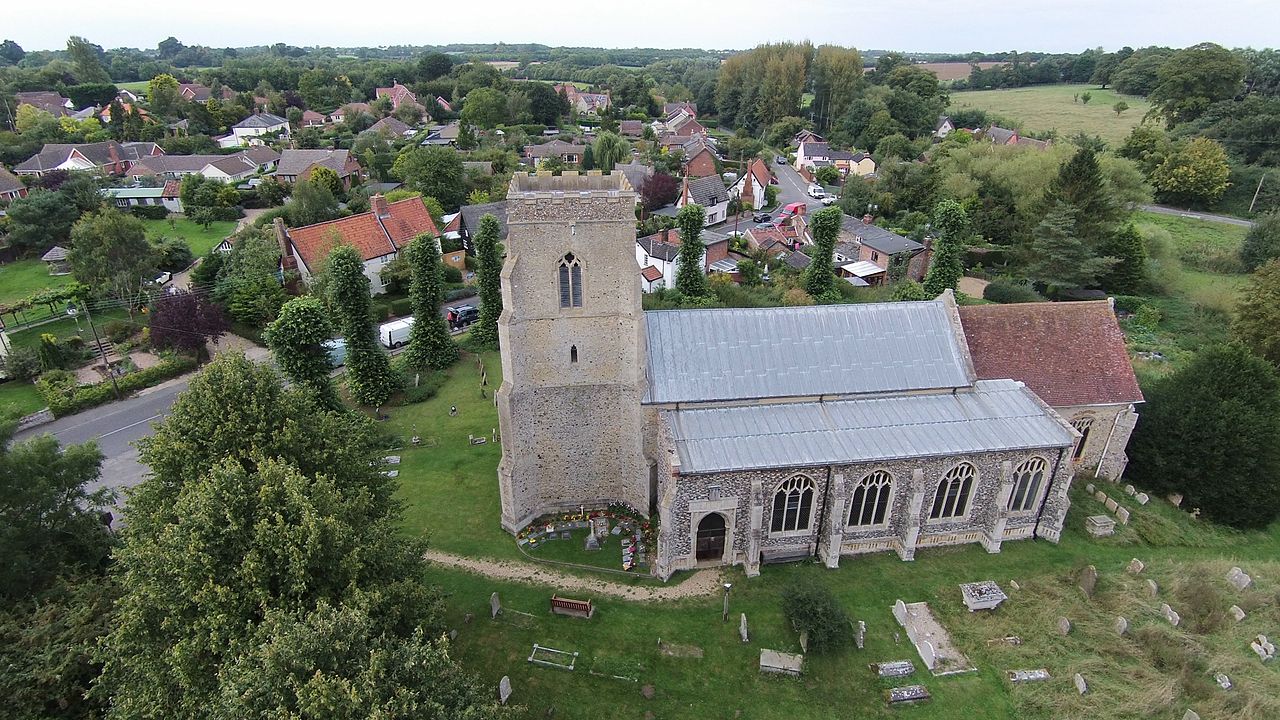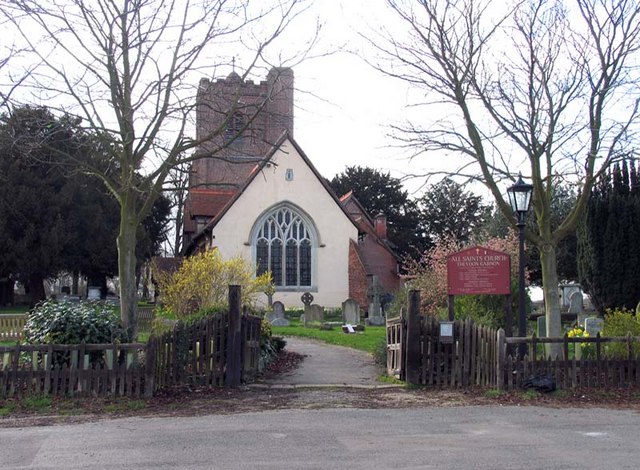My previous post on Thomas ended in
1879, when, probably still
the tenant of Down Hall Farm, he sold the Preston St Mary mill to one John Thomas Allen for £1,150. The
writer from whom I took this information describes it as a 'tidy sum'[1] -
and quite rightly so, as it's over £100,000 in modern terms, and much more
than that if you do the calculation in one of the other possible ways. Of
course, Thomas might not have been the sole owner of the windmill, but, however
many siblings he had to split it with, as a tenant farmer with cash in the bank
he was in a strong position, even though agriculture in Suffolk had been
depressed since the early 1870s. He certainly doesn't seem like a man on the verge
of financial disaster.
But when we reach the next
available record, the Census of 1881, that's exactly what's happened.
That Census records the family living in Debenham Road , Stonham-Aspal - I'll put all the places Thomas lived after
Preston St Mary in bold to bring out more clearly what happened to him and his
family. Stonham is about 17 miles from Preston ,
to the east of Stowmarket.
Google Maps
Thomas is a Farm Steward (Bailiff) and Harriet a
Dairy Woman - a note adds 'Ag(ricultural). Lab(ourer).' - like most of the village's population.

"1881 Occupational orders" by Afmoores - Own work. Licensed under CC BY-SA 3.0 via Commons
The children living with them are: Alice
Louise, aged 4, Herbert Sidney 2, and Katie Mary. Baby Katie was born in
Stonham Aspal and is only three weeks old; as her older brother Herbert was
born in Preston , we have an idea of when
Thomas moved: some time between Herbert's birth on October 5, 1878 and Katie's
on (roughly) March 11, 1881.

Further proof that Thomas had fallen on hard times, is that
the same Census shows that his oldest child, Arthur Thomas, had been sent to
live with his grandparents, the Worters, who farmed at Milden. (He was still
there in 1901, when he'd risen to 'farm manager'.)
Thomas was now no longer a farmer but the bailiff on another
man's farm. His wife was an ordinary agricultural labourer - like most British
people before the modern age. And, as we shall see, both parents and children
would take jobs completely typical of the era they lived in, one which still
had one foot in that traditional rural world, the other on the rapidly changing
terrain of modernity.
What had happened?
There is no documentary evidence to show the cause of
Thomas's disaster, but his grandson Wilfred ('Bay') Edgar explained it to me
thus:
I understood my
paternal grand-father had been sold up the river by Lloyds before WW1 and the family
dispersed.[2]
Although there is no documentary evidence to support the
claim that Thomas was let down or even swindled by Lloyds Bank, it does account
for the way in which a family that seemed to be doing well in 1879 had started
to go into decline by 1881. If Bay is correct, then our branch of the Edgars left
their small 'corridor' of Suffolk - from Combs to Preston - after more than 300
years of documented presence that was probably closer to twice that in fact -
because of the actions of a bank.
Still, Thomas and Harriet didn't have to move far, and the position
of farm bailiff was at least a responsible one - the fall from tenant farmer
was real, but not precipitious. Sadly Thomas's problems were only just
beginning.
There were clearly issues with the post at Stonham Aspal, as
within two years, Thomas and Harriet had turned back south-east, over-shooting
Preston St Mary, and ending up the other side of Lavenham. Stanley James Edgar was
born in Great Waldingfield, about
5 miles south of Lavenham, on March 3
1883. He was their fourth child - reader's of my previous post will know that Arthur Thomas Edgar was born on April
10, 1875, Alice Louise on September
12, 1876 and Herbert Sidney on
October 5, 1878 - all during the Preston St Mary period.
Google Maps
One source claims that Thomas was
in Great Waldingfield in 1882/1883 and that he was a farm bailiff there too. This seems plausible.

"St. Lawrence church, Great Waldingfield, Suffolk - geograph.org.uk - 151418" by Robert Edwards. Licensed under CC BY-SA 2.0 via Commons -
Next it was up north again, to Worlingworth, another ten miles
beyond Stonham Aspal, but still in Suffolk .
Google Maps
Alice Louise and Herbert started at
Worlingworth C. of E. Primary School on October 20, 1884. Kate joined them there on April 20, 1885. Their sister Annie Gertrude Edgar was born at Worlingworth, on July 23, 1885.
Then the family left Suffolk
for the first time - although no further than neighbouring Essex .
Wilfred Henry Edgar was born on May
28, 1888 in Tendring Essex.[3] When
he joined the Essex Militia in 1904 - he was a gardener in Romford at the time
- he gave Clacton as the parish of his birth.[4]
Tendring is just over 7 miles inland to the north of Clacton .
There were a number
of farms in the Tendring area, so perhaps they worked there rather than in Clacton
itself.
But they didn't stay there long. The next move took them
back to Suffolk .
Herbert started at Wetherden County
Primary School

Church of St Mary the Virgin, Wetherden
"Wetherden3" by DJIPhantom - Own work. Licensed under CC BY-SA 3.0 via Commons -
Wetherden is a tiny village 4 miles northwest of Stowmarket.
Google Maps
Stanley and Katie
Mary are also registered as having begun school on that date. The family were
living at Rose Cottage. Herbert and Katie are said to have previously attended a school at Clacton-on-Sea, But Stanley [5] and Annie Gertrude, who started on March 17 1890, were also attending for the first
time.[6] If the family were living in Tendring, as I suspect, it must have been a long, tiring day for Herbert and Katie as it's 8.5 miles from Clacton by road.
It wasn't long before the family moved yet again.
Frederick Johnson Edgar was born on 16 October 1890[7] at
Woodbridge , Suffolk . Woodbridge is just under 3 miles from Great Bealing(s), which is where the family are recorded as living in 1891.[8]
"GreatBealingsSign" by Phil Holmes at the English language Wikipedia. Licensed under CC BY-SA 3.0 via Commons -
Great Bealing(s) is in the south of the
county, just 6 miles from Ipswich - the base area of the richest branch of the Edgar family!
From the 1891 Census we learn
that Thomas had fallen still further down the social scale: he had now dropped
from the managerial role of bailiff to a mere 'agricultural labourer'. Harriet
it seems wasn't working, but Herbert was a farm worker like his father.
It's pretty clear why Thomas has been moving so often: since losing his farm
tenancy, he's failed to find a niche in the job market. And socially he's moved
downward, and there's not much further to go - but his next move, to the border with Cambridgeshire, must have offered him some hope that the bad times were coming to an end.

The couple's last child, Thomas John was born on April 17, 1894, in Gazeley, Suffolk and baptised in All Saints Church on May 13. The Baptismal record tells us that his father was a bailiff living in that village. If that's true then he had managed to claw back some of his social position and rise again from the role of mere labourer. If so, it was be a prelude to a fall to a position close to the bottom of the class structure.
Some time before the next Census the family moved back to Essex.
In 1901 they are living at Curter Hint Green, Stapleford Abbots, Ongar, Essex , England Stanley
is a postman. Wilfred joined the Militia as a reservist in 1904 and his Attestation
form has him working as a gardener for a Mr. Webb of Romford and living at Chigwell four miles from Stapleford Abbots.
Thomas was 58 and he'd lived in Preston St Mary until about
1880. In the succeeding twenty years he'd had seven homes. Our branch
of the Edgars had left their ancestral villages of Combs and Preston
for good. They were now in the dark world's fire: a rapidly urbanising and industrializing
society, an unforgiving jobs market that, for at least two of Thomas's
children, would include the territories of the British
Empire, and no welfare 'cushion' for the sick, the old or the unlucky . Furthermore, a brutal war, on a scale new in human history, was already
visible on the horizon; four of Thomas and Harriet's sons would fight in France, and one would not return.
But at least the couple had found a secure home before that conflict began. It would take two more moves to do it. And the first would see a new social humiliation for a man who began life as the son of a comfortably off tenant farmer.
But at least the couple had found a secure home before that conflict began. It would take two more moves to do it. And the first would see a new social humiliation for a man who began life as the son of a comfortably off tenant farmer.
Geographically Stanford Rivers is not too far from Stapleford Abbots but socially Thomas has dropped below the position of labourer he held there, and Harriet is recorded as working for the first time.

The 1911 Census - the last to be currently available - has
Thomas, Harriet, Wilfred and Thomas Jr. listed in the household of Horace S.
Palmer, a 22 year old farmer of Stewarts Farm, Toot Hill, Ongar, Stanford Rivers , Essex ,

Parish Church, Stanford Rivers
"Parish Church, Stanford Rivers, Essex - geograph.org.uk - 79855" by John Winfield. Licensed under CC BY-SA 2.0 via Commons
Thomas and Harriet are both listed as servants (housekeepers),
Wilfred and young Thomas are both unmarried, Wilfred's a reservist in the militia, Thomas a shop assistant.[9]
In pre-modern times -
already largely over by 1911 - most working class English women were domestic
servants. Thomas was now presumably too old at 68 for the heavy labour of the
fields, so he too was working in service. One might speculate that he was
employed as an adjunct to his younger (59) wife. There's really only one step
further down now, and Thomas and Harriet must have dreaded it: it's hard for
those of us lucky enough to have been born in Britain after WW11 to remember the
terror of our ancestors when faced with the thought they might end their lives
in the workhouse. In a future post I'll tell the story of an Edgar (a relation,
but not on the direct line) who spent several years in one of these dreadful
places with her children. But happily Thomas and Harriet avoided this fate.

Ongar Union Workhouse where the poor of Stanford Rivers were sent
Image: Blackmore Area Local History
http://blackmorehistory.blogspot.co.uk/2008/06/stanford-rivers-ongar-union-workhouse.html
There was one last journey that I've been able to find so
far although when they made it is uncertain.
Google Maps
While here Thomas became a churchwarden again.[11] According
to the letter from Bay Edgar, cited above, the couple lived in a 'grace and
favour' home (leased rent free to deserving citizens by the monarch or a
charity) suggesting money was still short (although one online estate agent
estimates its current value as in excess of £1.6 million![12]).
He had probably moved before September 1,1913, because on
that day at Theydon
Garnon Parish
Church

On April 11, 1920, Thomas, in his capacity as churchwarden, assisted at the unveiling of a memorial at All Saints to those who'd died in the war.
On it was the name of his son Thomas John:

Image: Blackmore Area Local History, http://blackmorehistory.blogspot.co.uk/2008/10/theydon-garnon-war-memorial.html
Harriet died later in the year - on November 11 - and Thomas on November 27, 1929, both in the Epping
District, probably in Theydon Garnon. Probate on Harriet's effects -
£367 5s. - was granted to Thomas, described as a 'farm bailiff'. Probate for Thomas was given to Stanley
James, at that time a grocer; the effects were £442 9s and 3d. This has about £24,000
purchasing value in 2014 terms - much more if you calculate by other methods. A
relatively humble sum, perhaps, but enough to suggest a modest recovery of
fortune from the days as an agricultural labourer or in domestic service.
In my next post I'll examine the fate of Thomas and
Harriet's children - expelled from the family domain and eventually scattered
all over the world.
[1] http://www.suffolkmills.org.uk/newsletters/072%20November%201998.pdf
[2] Bay
Edgar, undated letter to Brian Edgar.
[3]http://search.findmypast.co.uk/record?id=bmd%2fb%2f1888%2f3%2faz%2f000164&parentid=bmd%2fb%2f1888%2f3%2faz%2f000164%2f301&highlights=%22%22
[4]http://search.findmypast.co.uk/record?id=gbm%2fwo96%2f0762%2f112%2f001&parentid=gbm%2fwo96%2f762%2f1419112&highlights=%22%22
[5]http://search.findmypast.co.uk/record?id=gbor%2fschool%2fsuffolk%2fa2703_3%2f0073&parentid=gbor%2fschool%2fa27033%2f692015&highlights=%22%22;
http://search.findmypast.co.uk/record?id=gbor%2fschool%2fsuffolk%2fa2703_3%2f0076&parentid=gbor%2fschool%2fa27033%2f692123
[6]http://search.findmypast.co.uk/record?id=gbor%2fschool%2fsuffolk%2fa2703_3%2f0073&parentid=gbor%2fschool%2fa27033%2f692015&highlights=%22%22
[7]http://search.findmypast.co.uk/record?id=bmd%2fb%2f1890%2f4%2faz%2f000156&parentid=bmd%2fb%2f1890%2f4%2faz%2f000156%2f276&highlights=%22%22
[8] http://search.findmypast.co.uk/record?id=gbc%2f1891%2f1474%2f0149&parentid=gbc%2f1891%2f0010796255
[9] https://en.wikipedia.org/wiki/Stapleford_Abbotts
[10] http://www.everymanremembered.org/profiles/soldier/1752685/
[11] http://www.hellfirecorner.co.uk/duffell2.htm
[12] https://www.houser.co.uk/1,-mount-road-cottages,-mount-road,-theydon-garnon,-epping-cm16-7ph-p25929367
No comments:
Post a Comment